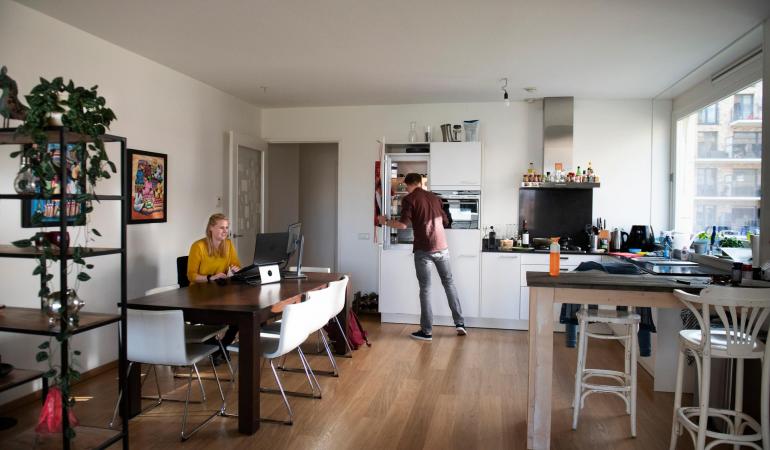
In the past week from 14-20 July 2021, the reported number of people who tested positive for COVID-19 increased by 34% compared to the previous week. In the past few days, cautious stabilisation has been observed in the number of people who tested positive for COVID-19.
The upcoming week will show whether the recent stabilisation in the reported number of people who tested positive will be transition into a downward trend.
The number of new patients admitted to hospital with COVID-19 in the past week increased to 205 admissions compared to the week before that. That is 120 more admissions than in the previous week. 31 new COVID-19 patients were admitted to ICU wards, 19 more admissions than in the week before.
Positive tests
The number of positive tests per 100,000 inhabitants increased, rising from 301 in the week before to 399 last week (+32%), Figure 1. Reported figures increased in all age groups.
The reported number of positive tests may have reached its peak in the past few days. Over the course of the next week, it will become clear whether a downward trend continues. Continuing the pattern of the last few weeks, the highest number of positive tests per 100,000 inhabitants was seen in the age group of 18-24 years. This was followed by the age groups of 13-17 years and 24-29 years. After a significant increase among people aged 18-24 in the week before, the number of newly reported positive tests in this age group levelled off last week (+4%). The number of positive tests increased last week among people in their thirties (+113%), forties (+183%), fifties (+183%), sixties (+246%), seventies (+272%) and eighties (+266%).
Nearly 464,000 people were tested for COVID-19 in the test lanes of the Municipal Public Health Services (GGDs) in the past calendar week, 23% more than the week before that. More testing took place in all other age categories, except for the age group of 18-24 years.
The percentage of positive tests in the GGD test lanes increased from 13.4% to 13.4% on a weekly basis*.
Figure 1.
All security regions have shown an increase in the number of positive tests per 100,000 inhabitants. The lowest numbers of positive tests were reported in the regions of Drenthe (170) and Zeeland (199). The highest numbers of positive tests were reported in the security regions of Amsterdam-Amstelland (782), Kennemerland (543) and Rotterdam-Rijnmond (518).
* This percentage of positive tests includes the tests that were taken in the context of travel. Excluding the number of tests taken in the context of travel (n=41,118), the percentage of positive tests is 15.3%.
Vaccination status
Between 1 July and 19 July, 126,874 people received a positive test result. The vaccination status of 100,294 (79%) of those people is known.
Of the people who tested positive and whose vaccination status was known at the time when they were tested, 9% were fully vaccinated, 14% were partly vaccinated, and 77% were not vaccinated (or not yet), Figure 2.
Footnote to figure 2:
The vaccination status is not known for all those tested. The term ‘partly vaccinated’ is used when someone has received a first vaccination more than 14 days ago, of a vaccine for which two doses are needed. A person is also partly vaccinated if the last jab of the doses needed for that was administered less than two weeks ago. A person is fully vaccinated two weeks after the last dose of the vaccination schedule. The people who tested positive for COVID-19 and were not yet fully or partly vaccinated consisted of the following groups: those who had not received any vaccine at all, those who had received 1 dose of the Janssen vaccine less than 14 days ago, and those who had received 1 dose of another vaccine less than 14 days ago.
Hospital admissions
205 new COVID-19 hospital admissions were reported last week, 120 more than in the week before, when 85 people with COVID-19 were admitted to hospital. 31 new ICU admissions were reported in the past week, an increase of 19 admissions compared to the week before, when 12 people with COVID-19 were admitted to ICU.
Age distribution of hospital admissions
The effect of the vaccination campaign can be seen clearly in the age distribution of people admitted to hospital with COVID-19, both in nursing ward admissions and ICU admissions (Figures 4 and 5)***. Until mid-May, more than half of the patients admitted to hospital with COVID-19 in the Netherlands were over the age of 60. At this point, just under one-third of people admitted with COVID-19 are 60 years and older. A decrease until early June was followed by a stabilisation; since the end of June, a slight increase has been observed in all age groups (source: NICE Foundation).
Figure 3: Hospital admissions by age group, by calendar week, from 3 May – 18 July 2021 (source: NICE Foundation)
Figure 4: Intensive care (ICU) admissions by age group, by calendar week, from 3 May – 18 July 2021 (source: NICE Foundation)
Reproduction number R
The reproduction number for 5 July based on positive COVID-19 tests decreased from 2.17 to 1.75 (lower limit 1.71 – upper limit 1.78). When the reproduction number is above 1, the number of people who are infected is increasing. A reproduction number of 1.75 means that 100 people with COVID-19 will collectively infect another 175 people.